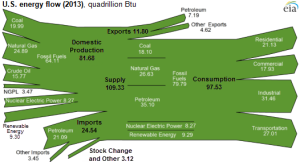US EIA: Domestic production filled 84% of US energy demand in 2013

Total US energy production reached 81.7 quadrillion British thermal units (quads) in 2013, the US Energy Information Administration (EIA) reported this week. That is enough to satisfy 84% of total US energy demand, which totaled 97.5 quads last year. Unsurprisingly, natural gas was the largest domestically produced energy resource for the third year in a row, the agency reported.

According to the EIA’s May Monthly Energy Review, fossil fuels, including natural gas, coal, crude oil and hydrocarbon gas liquids, accounted for more than three quarters of US energy production. In total, the United States consumed 97.5 quads of energy, 82% of which was fossil fuels. Renewable and nuclear energy made up 10% and 8%, respectively, of US energy consumption.
The portion of US energy consumption supplied by domestic production has been increasing since 2005, when it was at its historical low point of 69%. Since 2005, production of domestic resources, particularly natural gas and crude oil, has been increasing as a result of the application of new technologies. At the same time, reduced road travel, improved vehicle efficiency and competition among fuels for electric power generation have limited consumption of petroleum and coal.




